
Conistra ligula, the dark chestnut, is a moth of the family Noctuidae. The species was first described by Eugenius Johann Christoph Esper in 1791 and it is found in the Palearctic.
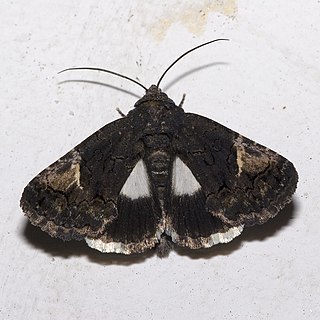
Aedia funesta or the druid is a moth of the family Erebidae. It is found in Central Europe, Southern Europe, Anatolia and Iran.
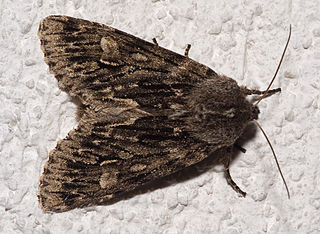
Brachionycha nubeculosa, the Rannoch sprawler, is a moth of the family Noctuoidea. It is found across the Palearctic from the British Isles in the west, across central and northern Europe over Russia, Siberia to China. The species is only locally distributed in central Europe, but is often relatively common in this region. In southern Europe, the occurrence is limited to some mountainous regions. In Germany, it reaches as far as the summit regions of the low mountain ranges. The species is moisture loving and prefers moist, cool temperate forests, mixed forests, wooded valleys, river and stream edges as well as orchards.

Katha depressa, the buff footman, is a moth of the family Erebidae found in Asia and Europe. It was first described by Eugenius Johann Christoph Esper in 1787.

Boloria titania, the Titania's fritillary or purple bog fritillary, is a butterfly of the subfamily Heliconiinae of the family Nymphalidae.
Atypha is a monotypic moth genus of the family Noctuidae erected by Jacob Hübner in 1821. Its only species, Atypha pulmonaris, was first described by Eugenius Johann Christoph Esper in 1790. It is found in southern and central Europe, northern Turkey, Transcaucasia and the Caucasus.

Auchmis is a genus of moths of the family Noctuidae.
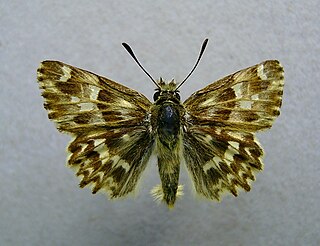
Muschampia lavatherae, the marbled skipper, is a butterfly of the family Hesperiidae. It is found from the Rhine Rift Valley in central Germany up to North Africa and from south-eastern France up to Anatolia.
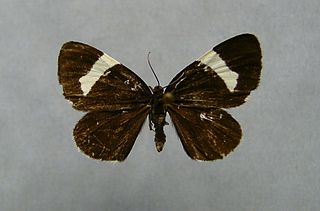
Baptria is a monotypic moth genus in the family Geometridae erected by Jacob Hübner in 1825. Its only species, Baptria tibiale, was first described by Eugenius Johann Christoph Esper in 1791. It is found in central and northern Europe.

Carcharodus is a Palearctic genus of skippers in the family Hesperiidae.

Catocala conversa is a moth of the family Erebidae first described by Eugenius Johann Christoph Esper in 1787. It is found in the Mediterranean zone and parts of the sub-Mediterranean zone.

Agrochola litura, the brown-spot pinion, is a moth of the family Noctuidae. The species was first described by Carl Linnaeus in 1761. It is found in Europe and the Middle East. It is possibly also present in North Africa, but this is unclear because similar looking species Agrochola meridionalis is found there.

Euxoa detersa, the rubbed dart, sandhill cutworm or sand cutworm, is a moth of the family Noctuidae. The species was first described by Francis Walker in 1856. It is found in North America from Newfoundland to North Carolina, west to Nebraska, north to Alberta and the Northwest Territories.

Apamea sublustris, the reddish light arches, is a moth of the family Noctuidae. The species was first described by Eugenius Johann Christoph Esper in 1788. It is found in central and southern Europe, Turkey and the Caucasus.

Xestia ochreago is a moth of the family Noctuidae.

Coleophora ornatipennella is a small moth of the family Coleophoridae.
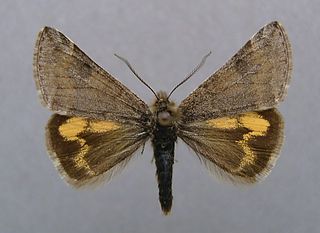
Boudinotiana puella, the pale orange underwing, is a moth of the family Geometridae. The species was first described by Eugen Johann Christoph Esper in 1787. It is found in isolated populations in central Europe, ranging to southern Russia in the east.
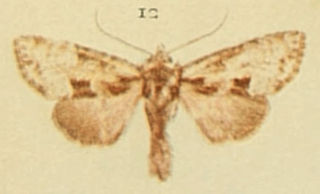
Eremobina pabulatricula, the union rustic, is a moth of the family Noctuidae. The species was first described by Nikolaus Joseph Brahm in 1791. It is found in continental Europe, southern Scandinavia and Central Asia. Never common in the British Isles, it has not been recorded there since 1935.
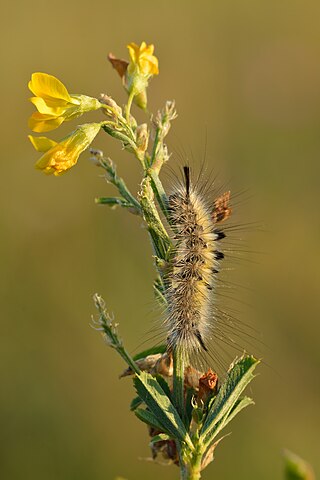
Gynaephora selenitica is a moth in the family Erebidae first described by Eugenius Johann Christoph Esper in 1789. It is found from central Europe through eastern Europe to the Urals and Ob' River in West Siberia. It is not found in western and southern Europe and Scandinavia.

Calophasia opalina is a moth of the family Noctuidae first described by Eugenius Johann Christoph Esper in 1793. It is found from Southern Europe to Central Asia.



















